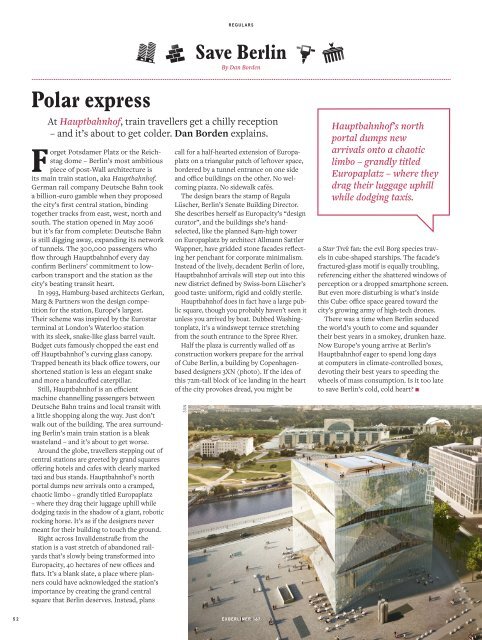Exberliner Issue 167, January 2018
You also want an ePaper? Increase the reach of your titles
YUMPU automatically turns print PDFs into web optimized ePapers that Google loves.
REGULARS<br />
Save Berlin<br />
By Dan Borden<br />
Polar express<br />
At Hauptbahnhof, train travellers get a chilly reception<br />
– and it’s about to get colder. Dan Borden explains.<br />
Forget Potsdamer Platz or the Reichstag<br />
dome – Berlin’s most ambitious<br />
piece of post-Wall architecture is<br />
its main train station, aka Hauptbahnhof.<br />
German rail company Deutsche Bahn took<br />
a billion-euro gamble when they proposed<br />
the city’s first central station, binding<br />
together tracks from east, west, north and<br />
south. The station opened in May 2006<br />
but it’s far from complete: Deutsche Bahn<br />
is still digging away, expanding its network<br />
of tunnels. The 300,000 passengers who<br />
flow through Hauptbahnhof every day<br />
confirm Berliners’ commitment to lowcarbon<br />
transport and the station as the<br />
city’s beating transit heart.<br />
In 1993, Hamburg-based architects Gerkan,<br />
Marg & Partners won the design competition<br />
for the station, Europe’s largest.<br />
Their scheme was inspired by the Eurostar<br />
terminal at London’s Waterloo station<br />
with its sleek, snake-like glass barrel vault.<br />
Budget cuts famously chopped the east end<br />
off Hauptbahnhof’s curving glass canopy.<br />
Trapped beneath its black office towers, our<br />
shortened station is less an elegant snake<br />
and more a handcuffed caterpillar.<br />
Still, Hauptbahnhof is an efficient<br />
machine channelling passengers between<br />
Deutsche Bahn trains and local transit with<br />
a little shopping along the way. Just don’t<br />
walk out of the building. The area surrounding<br />
Berlin’s main train station is a bleak<br />
wasteland – and it’s about to get worse.<br />
Around the globe, travellers stepping out of<br />
central stations are greeted by grand squares<br />
offering hotels and cafes with clearly marked<br />
taxi and bus stands. Hauptbahnhof’s north<br />
portal dumps new arrivals onto a cramped,<br />
chaotic limbo – grandly titled Europaplatz<br />
– where they drag their luggage uphill while<br />
dodging taxis in the shadow of a giant, robotic<br />
rocking horse. It’s as if the designers never<br />
meant for their building to touch the ground.<br />
Right across Invalidenstraße from the<br />
station is a vast stretch of abandoned railyards<br />
that’s slowly being transformed into<br />
Europacity, 40 hectares of new offices and<br />
flats. It’s a blank slate, a place where planners<br />
could have acknowledged the station’s<br />
importance by creating the grand central<br />
square that Berlin deserves. Instead, plans<br />
call for a half-hearted extension of Europaplatz<br />
on a triangular patch of leftover space,<br />
bordered by a tunnel entrance on one side<br />
and office buildings on the other. No welcoming<br />
piazza. No sidewalk cafés.<br />
The design bears the stamp of Regula<br />
Lüscher, Berlin’s Senate Building Director.<br />
She describes herself as Europacity’s “design<br />
curator”, and the buildings she’s handselected,<br />
like the planned 84m-high tower<br />
on Europaplatz by architect Allmann Sattler<br />
Wappner, have gridded stone facades reflecting<br />
her penchant for corporate minimalism.<br />
Instead of the lively, decadent Berlin of lore,<br />
Hauptbahnhof arrivals will step out into this<br />
new district defined by Swiss-born Lüscher’s<br />
good taste: uniform, rigid and coldly sterile.<br />
Hauptbahnhof does in fact have a large public<br />
square, though you probably haven’t seen it<br />
unless you arrived by boat. Dubbed Washingtonplatz,<br />
it’s a windswept terrace stretching<br />
from the south entrance to the Spree River.<br />
Half the plaza is currently walled off as<br />
construction workers prepare for the arrival<br />
of Cube Berlin, a building by Copenhagenbased<br />
designers 3XN (photo). If the idea of<br />
this 72m-tall block of ice landing in the heart<br />
of the city provokes dread, you might be<br />
3XN<br />
Hauptbahnhof’s north<br />
portal dumps new<br />
arrivals onto a chaotic<br />
limbo – grandly titled<br />
Europaplatz – where they<br />
drag their luggage uphill<br />
while dodging taxis.<br />
a Star Trek fan: the evil Borg species travels<br />
in cube-shaped starships. The facade’s<br />
fractured-glass motif is equally troubling,<br />
referencing either the shattered windows of<br />
perception or a dropped smartphone screen.<br />
But even more disturbing is what’s inside<br />
this Cube: office space geared toward the<br />
city’s growing army of high-tech drones.<br />
There was a time when Berlin seduced<br />
the world’s youth to come and squander<br />
their best years in a smokey, drunken haze.<br />
Now Europe’s young arrive at Berlin’s<br />
Hauptbahnhof eager to spend long days<br />
at computers in climate-controlled boxes,<br />
devoting their best years to speeding the<br />
wheels of mass consumption. Is it too late<br />
to save Berlin’s cold, cold heart? n<br />
52<br />
EXBERLINER <strong>167</strong>


















